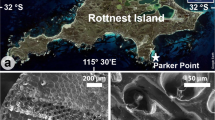Abstract.
We examined trace metal ingestion and assimilation (Cd, Se, Zn) by the green mussel Perna viridis in a mixture of diatoms and sediment at concentrations below and above the pseudofeces production levels. Dual gamma radiotracers (109Cd, 65Zn) were used to investigate particle selection on marine diatoms and sediments. The diatom (Thalassiosira weissflogii) was radiolabeled with 109Cd, and the natural sediment was radiolabeled with 65Zn. By comparing the ratios of 109Cd:65Zn in the particle mixture, mussel tissues and pseudofeces within a short-term exposure period (35 min), the results demonstrated that the green mussels were able to selectively ingest the diatom particles at a high particle load. Efficiency of selection for nutritious particles (e.g. diatoms) increased with increasing ratio of sediments in the particle mixture. Pseudofeces contained a higher ratio of sediments relative to that in the feeding suspension. No major particle selection was observed at concentrations below the level for pseudofeces production. The assimilation of Cd, Se and Zn by the green mussels was quantified using a pulse-chase feeding technique. The assimilation of Se and Zn by the green mussels from ingested diatoms was reduced with the presence of sediment within the mussel gut, presumably due to the resorption of metals onto the sediment, leading to a quicker passage of metals through the digestive tract and a lower proportion of metals subjected to intensive digestion. In contrast, the presence of diatoms did not significantly affect metal assimilation from ingested sediment. A significant correlation between metal assimilation efficiency and metal gut passage time was also observed. Metal assimilation by the green mussels appeared to be little dependent on the particle concentration in seawater. Our study suggests that particle selection may potentially alter metal influx from ingested food sources, particularly at high particle concentrations. Selective feeding of nutritious particles, coupled with a high assimilation efficiency from these ingested particles, may increase metal influx into mussels from the dietary phase.
Similar content being viewed by others
Author information
Authors and Affiliations
Additional information
Electronic Publication
Rights and permissions
About this article
Cite this article
Ke, C., Wang, WX. Trace metal ingestion and assimilation by the green mussel Perna viridis in a phytoplankton and sediment mixture. Marine Biology 140, 327–335 (2002). https://doi.org/10.1007/s002270100696
Received:
Accepted:
Issue Date:
DOI: https://doi.org/10.1007/s002270100696




